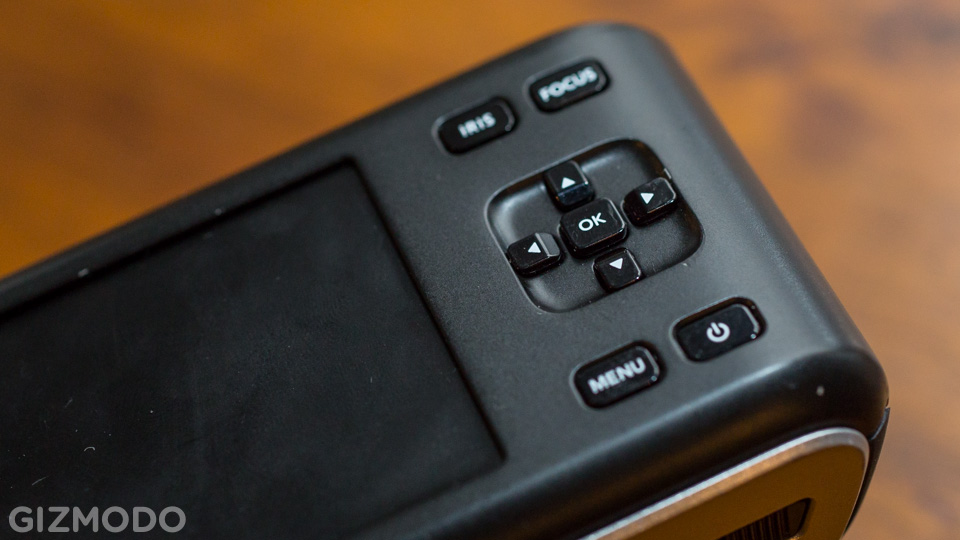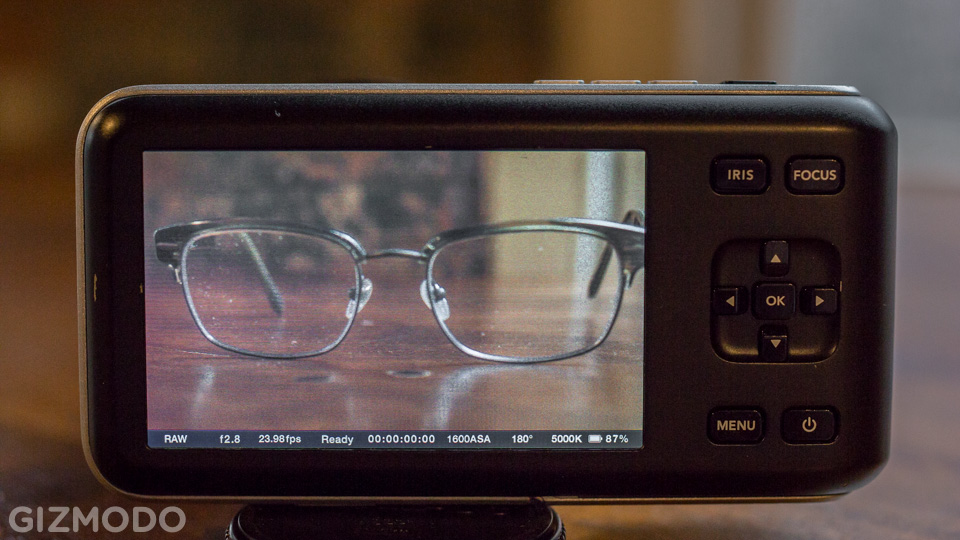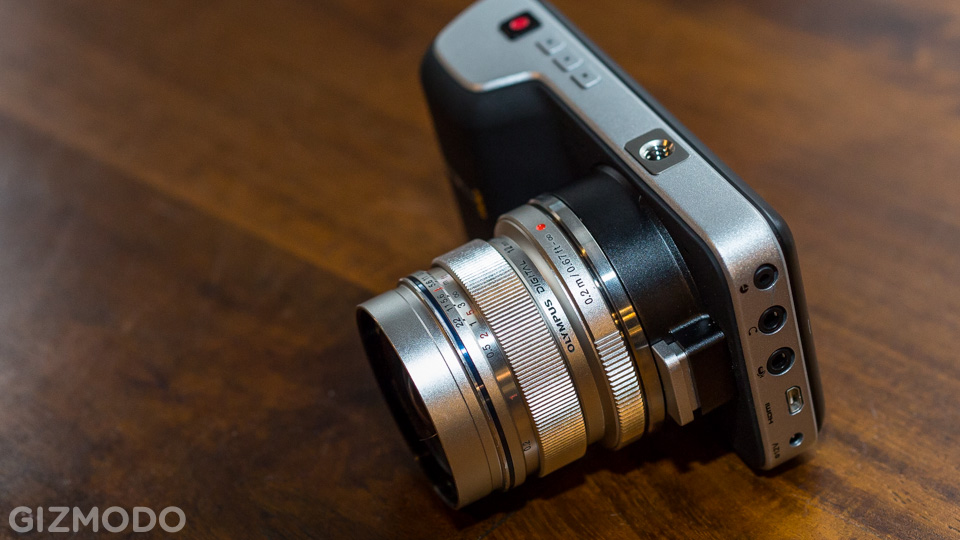The announcement of Blackmagic’s $US3000 RAW-shooting Cinema Camera in 2012 caused such a stir that not many could have anticipated a followup model, so soon, that was a fraction of the cost and a fraction of the size. The Pocket Cinema Camera continues forging the path of the upstart high-end video camera.
What Is It?
It’s a surprisingly small $US1000 video camera with a super-16 size sensor (a bit smaller than micro four-thirds). It takes micro four-thirds lenses and shoots ProRes or CinemaDNG RAW footage to SD cards. The basic innards are the same as the original Cinema Camera, just outfitted to squeeze into the 5-inch wide, 354g magnesium alloy body.
Why Does It Matter?
As with original Cinema Camera in 2012, it’s unprecedented to have access to RAW (or even ProRes) recording at this price. It opens the doors for those on a budget to sink their teeth into professional-grade image quality and post-production. For the unfamiliar, RAW is an uncompressed format that is meant to be colour-graded. It provides wide dynamic range, and can be manipulated heavily with very little loss in quality. Usually professional film productions use RAW, and it has been limited to cameras well over $US10,000 until recently.


Design
The Pocket Cinema Camera looks and feels much like a Sony NEX camera body. It’s slim and light, with a hearty rubberised grip to sink your claws into. It’s a stark contrast to the original, much larger, Cinema Camera, which provided absolutely nothing as far as grip. The back of the Pocket features a 3.5-inch LCD and buttons for auto-iris, auto-focus, menu, power, and a directional pad, in addition to a few on top, including the record button and playback controls. On the left side you will find inputs/outputs for audio, power, and external display.
Everything about the look and layout of the camera is utterly simple. Blackmagic had to make it that way in order to keep costs down. The effect is that you feel like you are holding a sturdy product with very few breakable parts, but also that it might be lacking in essential physical controls, which it is.
Using It
By virtue of sharing the same sensor as the Cinema Camera, we know the pocket version delivers the same amazing image quality. That means more dynamic range and detail than any DSLR, decent in low light with a tight, pleasing noise pattern. No news there. But the viability of the Pocket Cinema Camera lies in its ease of use.
The controls are clear, as are the menus. After powering on the camera, you have access to aperture control, a very slow autofocus, and that’s essentially it. It’s all easy, but limited.
You have to dive into the menus to change ISO, shutter angle, or white balance. It’s an odd choice, because these functions could easily be hidden in double-clicks or long-holds, the way the focus peaking is toggled by double-clicking the focus button. Instead you have to enter a menu system. What’s worse, the most commonly changed settings take a while to access. If you are going to make the shooter access a menu, the first settings to appear should be ISO, white balance, format, and frame-rate, among others. Instead, the first settings you are presented with after pressing the “Menu” button are Camera ID, Date, and Time. Why?
There are other unwelcome quirks, such as the inability to format an SD card in-camera, and the resetting of the aperture to auto every time you power it on.

Once you do (finally) get your settings dialed in, you’d better have a whole mess of Nikon EN-EL20 batteries. Those suckers only last for about 45-60 minutes of continuous recording. Luckily, they are cheap-ish and charge in a couple of hours or so. Still, it’s limiting.
Focusing your shot, meanwhile, is going to require using the extremely slow autofocus button (which only works with native micro four-thirds lenses), or you can magnify the image and manually focus. Peaking isn’t super reliable and doesn’t show up very well in low light. Whatever happens, don’t try to accurately find focus with just the bare LCD image. It’s impossible to do consistently.
Audio is another struggle with the Pocket Cinema Camera. The onboard mic is tiny, and though there is a mic jack on the side, the internal pre-amp isn’t powerful enough for high quality results. It’s basically good for reference audio. You can set the audio levels in the camera’s menu, but there are no on-screen meters whilst recording. Pro quality sound should be recorded externally.
Perhaps the most frustrating part of shooting handheld with the camera is lack of stabilisation. The camera does support optically stabilised micro four-thirds lenses, but only those with a physical button on the lens for enabling the feature. There aren’t many around. Without it, steady handheld footage is difficult. For casual home-video kind of shooting you might be fine, but that’s really not what this camera is for. It is made for those seeking high-quality results, and shaky footage kills that prospect.
All these problems can be solved by adding attachments and turning the Pocket Cinema Camera into a rig. Add an external monitor, audio recorder, shoulder stabilizer or tripod, and you’ve got a much more practical setup. But doesn’t that defeat the purpose of the form-factor? The camera has Pocket in its name, implying that it is meant to be used in run and gun situations. No crew, no giant rigs. It’s a challenge, but you can make it work if that’s your style. And frankly, for all the limitations, you’ll want to when you see the images this thing can shoot.
We’ve fawned over the footage coming out of the original Cinema Camera, and the Pocket is no different. It’s outstanding, luscious, and the fact that you are recording to ProRes or RAW — formats that will give you tons more control in post-production than the standard AVCHD or H.264 — is invaluable. These cameras were made with colour-grading in mind, and that’s half the fun of working with them. The image quality is so nice that it makes all the camera’s flaws recede into the background, which is sort of Blackmagic’s strategy in general: Give the user low cost access to superb, pro quality images, and let them figure out the rest.
In this sense you can’t really fault Blackmagic for many of the camera’s shortcomings, because fixing them would raise the cost of the camera and defeat the whole purpose. Yes, there is a balance to be had, and you could say that an additional $US500 on the price of the camera would justify some added features or better controls. At the very least, the firmware needs revising. Badly.

Like
It yields amazing image quality that exceeds any camera below about $US5000. The ability to record RAW files is completely unique and awesome, though very system-intensive. It’s small, portable, and easy to figure out. The active micro four-thirds mount gives access to a variety of high quality lenses. You can’t beat the price, or really get anywhere near it for this type of video quality. Batteries are cheap and quick to charge.
No Like
Usability suffers greatly due to cost constraints. There are very few controls that are accessible outside of the menu system. Audio is rudimentary and underpowered even with an external mic. No internal image stabilisation makes for shaky handheld footage with most lenses. Reliable recording requires extremely fast and high capacity SD cards. Battery life is poor.

Should You Buy It?
Clearly the Pocket Cinema Camera has a lot riding against it. But I have no hesitation in saying that for certain applications, it’s still worth buying. If you need something cheap, and want top notch-image quality, this camera could be for you. It’s not for home-video, it’s not for beginners. If you’re looking for something versatile and practical, check out the Sony RX10 for $1500, and if you have a bigger budget, check out the Canon C100 for around $5000. Both are more complete, and all-around great cameras, but neither of them offers the flexible recording formats that Blackmagic does.
The Pocket Cinema Camera is great for capturing B-roll, for short films, for certain styles of documentary. I would buy it as a companion to my 5D Mark III! Overall, it’s for beautiful video, nothing more, nothing less.
